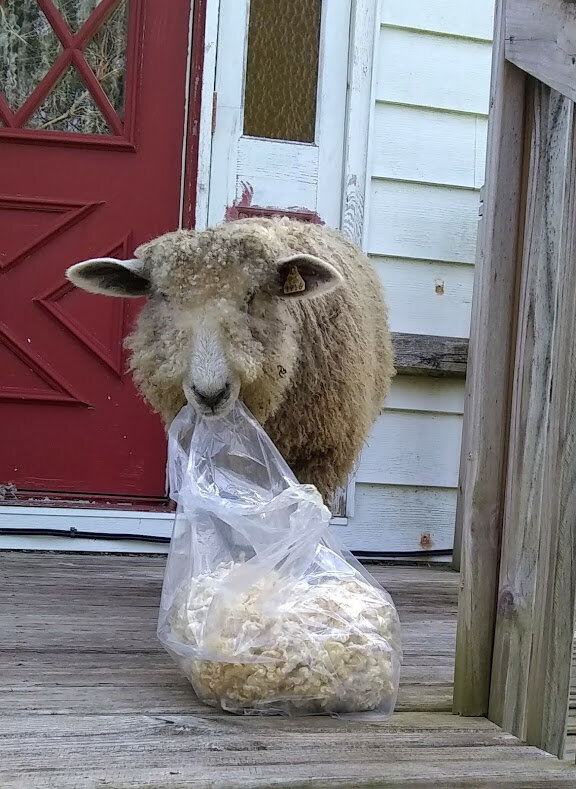We do not believe sheep shearing is inhumane if done correctly. Shearing sheep each year is one of the most important parts of their care. Left unshorn, sheep can have a myriad of health problems that are all equally horrible—from fly strike to heat stroke, sores and more--even the inability to move correctly when the fleece tangles and matts around their legs. Imagine never washing your hair or cutting it- that would be pretty gross right? It is the same for sheep.
Pictured is our Gabriella, a Cotswold sheep. She was a sheep with a lot of wool growth on her face. It is so very cute! However, if she wasn't sheared every year AND her bangs kept trimmed the rest of the year- she would go 'wool blind.' That can lead to a sheep becoming permanently blind if left unattended.
Example: Mary and I spent over an hour shearing a little sheep who had not been shorn for several years. That poor sheep had an approximately 20 pound + fleece that was completely tangled, matted and filthy. She had a collar embedded around her neck that had to be cut away with a bolt cutter and the fleece we removed had to be thrown away. Luckily, despite the 4 inches of matt, we were able to leave about 2 inches of good wool on her to keep her warm the rest of the winter. The little ewe is older and was so happy to be free of that mess that she fell asleep while we were shearing her. The people who gave her to my friend had taken excellent care of her otherwise, things changed in the family and they were later unable to find a shearer that would make a trip for one sheep.....
While it is important to shear, it is equally, if not more important to have a kind, caring shearer who is skilled and careful with the sheep. We have several sheep who have had broken limbs, arthritis and even our little Trillium who is missing her front leg. We spent a lot of time looking for a great shearer and have found Ryan Ullom. He is just wonderful. He is so careful and kind to the sheep, takes a break if they are scared and talks to them (although he may not want us broadcasting that part! Ha!)
Shearing is accomplished by setting the sheep on its hinder and carefully turning the sheep to shear the entire fleece. He is careful not to cut them with the clippers and the whole ‘ordeal’ is over in about 5 minutes or less per sheep. The gift in a shearer is definitely personified by Ryan, he has a unique way of handling the sheep that keeps them calm and comfortable—cradling them so there are not any injuries or traumatic experiences….
Years ago we had Angora and Pygora goats. Each spring and fall we sheared them ourselves—they are easy to work on and require nothing more than a scratch on the head to keep them standing still for me. We also have several sheep who we shear that are just easy enough to do, keeping them from being traditionally sheared to keep the stress off their once broken limbs.



















